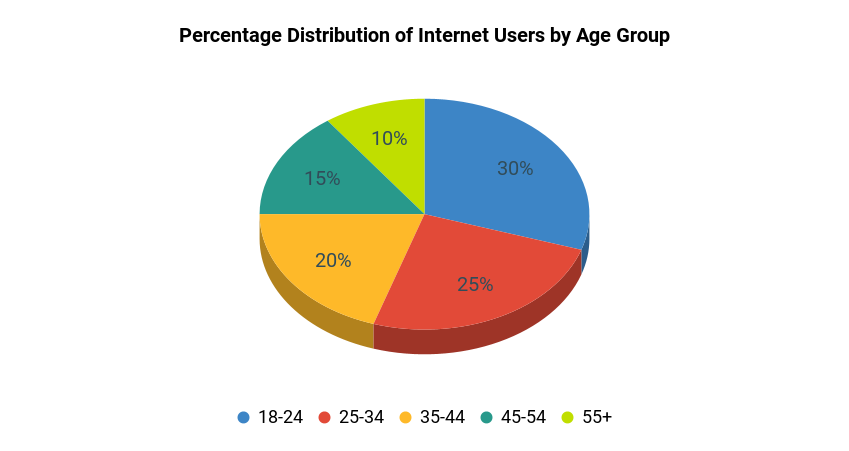- IELTS WRITING TASK 1
Percentage Distribution of Internet Users by Age Group
You should spend about 20 minutes on this task.
The chart below provides information about the percentage distribution of internet users in a country by age group.
Write at least 150 words describing the information shown in the chart. Analyze the age group distribution of internet users and discuss any patterns or trends that emerge.

Sample Answer, C1 English Level, Advanced, Band Score 6.5-7.5
The provided chart depicts the distribution of internet users in a particular country according to different age groups. The highest proportion of users, at 30%, falls within the 18-24 age range. The 25-34 group constitutes 25%, followed by 20% for the 35-44 age group. The 45-54 age bracket accounts for 15%, and individuals aged 55 and above represent 10% of internet users.
From the chart, we can deduce that younger people, specifically those aged 18-34, comprise a significant portion of internet users. This trend indicates that digital engagement is notably higher among the younger generation. However, as age increases, internet usage gradually decreases. It’s interesting to note that the 55+ category, although the smallest, still contributes 10% of users, suggesting that even older individuals are embracing online platforms.
In summary, the chart underlines a clear generational divide in internet usage, with the younger population being more digitally connected. This reflects the evolving nature of technology adoption and highlights the importance of catering to different age groups in digital initiatives.
Essay:
The chart presents the distribution of internet users in a certain country by their age groups. The highest percentage, at 30%, belongs to the 18-24 age range. The 25-34 age group follows with 25%, while the 35-44 group makes up 20%. The 45-54 group accounts for 15%, and the 55+ age group represents 10% of internet users.
From the chart, it’s clear that the younger age groups, particularly those between 18 and 34, have the most internet users. This shows that internet usage is higher among younger people. As age increases, the percentage of users gradually decreases. Interestingly, even the 55+ group has a portion of internet users, indicating that some older individuals are also using the internet.
In conclusion, the chart demonstrates that younger people use the internet more, while older people use it less. This suggests that technology is becoming more common among all age groups, but younger people are more active online.
Essay:
The presented chart gives an overview of how internet users are distributed across different age groups in a particular country. Notably, the largest chunk of users, comprising 30%, falls within the 18-24 age bracket. Following this, the 25-34 group constitutes 25%, while the 35-44 and 45-54 groups make up 20% and 15%, respectively. Interestingly, individuals aged 55 and above account for 10% of the internet users, showing that even older generations are embracing online platforms.
The chart underscores a clear generational divide in internet usage patterns. Younger individuals, specifically those aged 18-34, demonstrate a higher level of digital engagement. However, even as age increases, internet usage remains present, with the 55+ group also participating to some extent.
To summarize, the chart reveals that internet usage is prevalent across age groups, with the younger generation leading the way. This emphasizes the transformative impact of technology on society, indicating that people of all ages are becoming more digitally connected.

